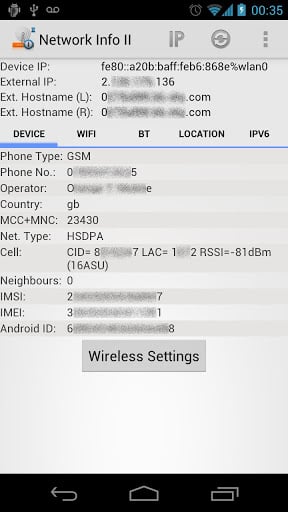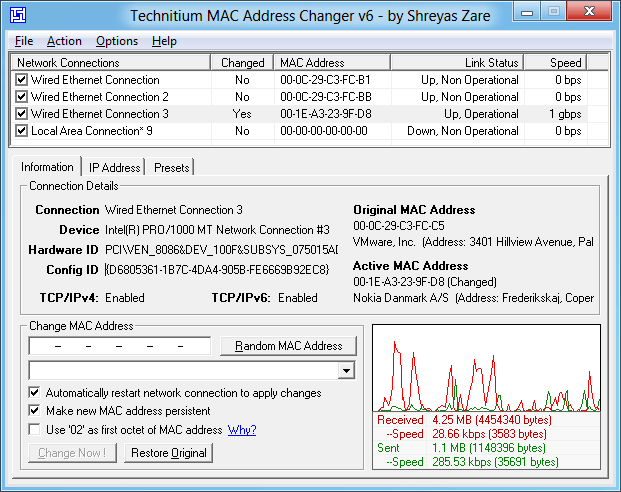Network switches or Layer 2 technology Ethernet protocol uses MAC addresses in order to transfer frames between systems. MAC addresses are 48-bit value. This 48-bit value contains the device manufacturer ID as the first 24 bit. In this tutorial we will learn how to look, search and find the Organizationally Unique Identifier in Linux distributions like Ubuntu, Debian, Mint, Kali, Fedora, CentOS, RHEL, etc.
Mac Address
Tired of paying a subscription service to access an API to resolve MAC address OUI/vendor data? Just resolving locally and maintaining your own database with this project is faster, cheaper (FREE!), and more secure. For an extra fee to IEEE, vendors can hide their details. In this case, this flag is set to 'true' and companyName, companyAddress and countryCode are 'private'. Name of the company which registered the MAC addresses block. Company's full address. Company's country code in ISO 3166 format. Date when the range was allocated, in YYYY-MM-DD format. Ieeeouidownloader What is this. Download the Ethernet MAC address database (which is a file) from the IEEE server that publishes it, compare it with an existing nmap MAC address database (which is a file) and generate a new nmap MAC address database containing any entries missing in the existing one. MAC vendors database download Get the most comprehensive database of registered MAC address blocks, also referred to as OUIs (Organizationally Unique Identifiers). We deliver complete and relevant data.

As stated in the previous part MAC address is used to address and route Ethernet frames. MAC address consists of a 48-bit value and simply expressed as the hexadecimal format. Here is an example of MAC Address.
OUI (Organizationally Unique Identifier)
OUI or Organizationally Unique Identifier is the first 24 bit or 6 hexadecimal value of the MAC address. IEEE is responsible for the OUI in MAC addresses. They provide the Ethernet card manufacturer company. In the previous example 00:50:56 is OUI of the MAC address.
Print MAC Address
First, we will start by printing the MAC address of the system. There are a lot of commands those have used to print MAC address but the ip link command is the easiest way.
Find OUI with get-oui Command
get-oui command is the most popular way to learn OUI . It is provided by arp-scan package. We can install arp-scan package like below.
Ubuntu, Debian, Mint, Kali

Fedora, CentOS, RHEL
Find OUI with ieee-data
ieee-data is another package which provides the oui.txt file . We can install this with the following commands
Ubuntu, Debian, Mint, Kali
Fedora, CentOS, RHEL
Search and Look For OUI In oui.txt
Installing previously explianed commands will create a file named oui.txt in the /usr/share/ieee-data/oui.txt this file provides the OUI data.
Lets look into oui.txt file to learn its format.
As we can see the first column is about OUI and the second column provides the organization name and the address of the organization. OUI is written in two formats first one is dash-separated and the other is without a separator.
Lookup Using Less
We will lookup using less command provided by Linux system. We will open the oui.txt file and search with /
AND then put the OUI . In this example we search for 00179A or 00-17-9A
OR

Lookup Using Grep

We can also use grep command to search and filter OUI. We will provide the OUI part and the oui.txt file as below. In this example, we will search for 00179A or 00-17-9A
OR
Lookup Using Nmap Mac Prefixes File
nmap is a popular network scanner which provides a lot of features. One of them is the OUI information. OUI information is stored in a file /usr/share/nmap/nmap-mac-prefixes . Kamen rider 555 ps2 iso emuparadise. We can search for a given OUI in this file with the grep command. Textbook of pedodontics shobha tandon pdf. First we need to install nmap package if it is not installed.
Ubuntu, Debian, Mint, Kali:
Fedora, CentOS, RHEL:
Now we will search with grep the OUI 0024A5 in this case.
Users rarely modify this file, which maps MAC address prefixesto vendor names. Read on for the complete treatment.
Ethernet devices, which have become the dominant networkinterface type, are each programmed with a unique 48-bit identifierknown as a MAC address.This address is placed in ethernet headers toidentify which machine on a local network sent a packet, and whichmachine the packet is destined for. Humans usually represent it as ahex string, such as 00:60:1D:38:32:90.
To assure that MAC addresses are unique in a world withthousands of vendors, the IEEE assigns an Organizationally UniqueIdentifier (OUI)to each company manufacturing ethernet devices. Thecompany must use its own OUI for the first three bytes of MACaddresses for equipment it produces. For example, the OUI of 00:60:1D:38:32:90is 00601D. It can choose the remainingthree bytes however it wishes, as long as they are unique. A counter is thesimple approach. Companies that assign all 16.8 million possible valuescan obtain more OUIs.nmap-mac-prefixes maps each assigned OUI to thename of the vendor that sells them.Example 14.6is a typical excerpt.
Oui Mac Vendor
Example 14.6. Excerpt from nmap-mac-prefixes
Mac Oui Database Download Software
The first value is the three-byte OUI as 6 hex digits. It isfollowed by the company name. This file is created from the complete list athttp://standards.ieee.org/regauth/oui/oui.txtby transforming it with a simple Perl script.The IEEEalso offers an OUI FAQ at http://standards.ieee.org/faqs/OUI.html.
Oui Mac
Nmap can determine the MAC address of hosts on a local ethernetLAN by reading the headers off the wire. It uses this table to lookup and report the manufacturer name based on the OUI. This can beuseful for roughly identifying the type of machine you are dealingwith. A device with a Cisco, Hewlett Packard, or Sun OUI probablyidentifies a router, printer, or SPARCstation, respectively. Example 14.6, “Excerpt from nmap-mac-prefixes” shows that the deviceat 00:60:1D:38:32:90 was made by Lucent. It is infact the Lucent Orinoco wireless card in my laptop.